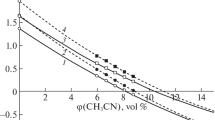Summary
Although Michael Tswett is the originator of chromatography, little is known about the performance of his chromatographic systems. His descriptions of the separation of plant pigments are detailed but nevertheless difficult to interprete by today's chromatographic theory. By our own experiments with the system calcium carbonate/benzene it was found that the separation factor of chlorophyll a and b is approx. 1.6 which means that less than 100 theoretical plates are necessary for separation. Tswett's columns with 50 μm particles and 2–3 cm of bed height presumably exceeded this plate number. His separations could have been impaired by mass overload and by a volume flow rate which was two orders of magnitude faster than the optimum.
Similar content being viewed by others
References
L.S. Ettre, A. Zlatkis, eds., “75 Years of Chromatography — A Historical Dialogue”, Elsevier, Amsterdam, 1979.
L.S. Ettre, V.R. Meyer, J. Chromatogr.600, 3 (1992).
Sh.A. Karapetyan, Khimia i Zhizn (Chemistry and Life)3, 86 (1985).
M. Tswett, Ber. Deut. Bot. Gesellsch.24, 384 (1906).
M. Tswett, “Khromofilly v Rastitel'nom i Zhivotnom Mire” (Chromophylls in the Plant and Animal World). Karlassiakoff, Warsaw, 1910.
V.G. Berezkin, M.R. Masson, eds., “Chromatographic Adsorption Analysis, Selected Works of Mikhail Semenowich Tswett”, Ellis Horwood, Chichester, 1990.
M. Tswett, Z. physikal. Chem.76, 413 (1911).
H.C. Sorby, Proc. Roy. Soc.21, 442 (1873).
T. Robinson, Chymia6, 146 (1960).
“Gmelins Handbuch der anorganischen Chemie”28 (Teil B, Lieferung 3), Verlag Chemie, Weinheim, 1961; p. 864. 899–900.
H.H. Strain, J. Sherma, M. Grandolfo, Anal. Biochem.24, 54 (1968).
W. de Rogowski, “Recherches sur les Spectres d'Absorption Ultra-Violets et sur les Spectres d'Emission par Fluorescence des Piqments Chlorophylliens”, Ph.D. Thesis, Fribourg, Warsaw, 1914.
P.A. Bristow, J.H. Knox, Chromatographia10, 279 (1977).
C.R. Wilke, P. Chang, Am. Inst. Chem. Engr. J.1, 264 (1955).
“Beilsteins Handbuch der organischen Chemie”26 (3. und 4. Ergänzungswerk), Springer, Berlin, 1982; p. 3243.
J.C. Giddings, “Dynamics of Chromatography”, Marcel Dekker, New York, 1965.
L.S. Ettre, lecture given at the 8th Danube Symposium on Chromatography, Warsaw, Sept. 1991.
Author information
Authors and Affiliations
Additional information
Dedicated to Professor Leslie S. Ettre on the occasion of his 70th birthday.
Rights and permissions
About this article
Cite this article
Meyer, V.R. Michael Tswett's columns: Facts and speculations. Chromatographia 34, 342–346 (1992). https://doi.org/10.1007/BF02268366
Received:
Accepted:
Issue Date:
DOI: https://doi.org/10.1007/BF02268366




